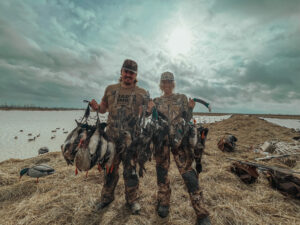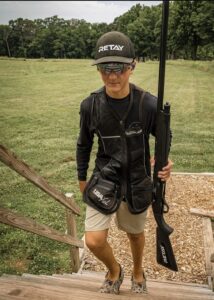
A cannonball in the shallow end of shotshell selection
By: TJ Rademacher
In my last article I talked about the evolution of the modern waterfowl shot shell and how we have gotten back to offerings available that closely match the performance of lead. Hell, in some ways they might be better. So, you’ve got a whole lot of choices! Honestly, you can do well with any of the modern offerings. The knowledge I’m about to leave with you will help you understand what sizes of shot in a given material for some general situations. Some of this might surprise you.

Since we are talking about shot let’s talk about chokes for a minute before we get too deep into this. Chokes obviously effect your pattern size and density (pellet count) through tighter or looser constrictions. You can go as far down the rabbit hole as you want on how company A guarantees 50% denser patterns and company B says birds will actually put themselves on your strap because if the decreased shot string length produced by their wad grabber technology. I don’t care what kind of snake its named after or what type of violent weather pattern its supposed emulate. Your choke and shotgun combo will literally be not worth a damn if you don’t pattern it with whatever load you choose to run through it. One more thing to consider for those who can’t or choose not spend money on some of the more expensive choke options your shotgun probably came with a few factory chokes. Just because its stock doesn’t mean it doesn’t work. Try them out with some of the partial boxes of shells you have. Get some cardboard out draw a 40-inch circle on it and shoot it. The results may surprise you.
Let me preface this next part with the following, it’s an educated opinion. I’m not a ballistician and my physics formula game is weak so if you don’t completely agree with everything I have to say I’m sorry for any imperfections. There are tons of studies about the actual science of why a certain shot size does what it does as it travels down range or when it makes contact with a bird. I highly suggest you read some of the stuff by Tom Roster if you want a real understanding of the science. If you like the details like me, you will find this information extremely interesting. This is not that kind of article though. I’m going off the research that I was able to digest from folks like Tom over the years and the experiences I have had in the field. Here are the cliff notes.
Ditch the 3.5 inch shells. You don’t need them. The tradeoff for more powder and heavier pay loads is more recoil. Recoil affects your ability to be able to get back on target after you either miss or you are trying to get after that other drake you see slipping out the back. Even if you are pass shooting I hold the same opinion. If you are shooting a steel shot shell, I recommend a 3inch shell. You can get more than enough speed to kill birds as long as you are choosing the right size shot and plenty enough payload for dense patterns. If you choose to go with Bismuth or tungsten I maintain that you really don’t need anything more than a 2 ¾ inch shell for birds inside of 40ish yards. This is because we are back to the near lead performance level with bismuth and way beyond with tungsten. I’ve also found that tungsten, bismuth and steel pattern out of 2 3/4 and 3 inch shell more uniformly and denser than 3.5-inch shells in my results. This is just my experience, but hey it jives with the science too. It’s weird how that stuff works.
On to shot size. I don’t really see why you would need to shoot more than BB in a quality steel load for any North American waterfowl. To be completely honest I think #2 shot is plenty if your pattern is doing what is supposed to and you are being ethical with your distances. Here is why the shot is roughly a sphere. It’s not super aerodynamic like a bullet so the larger the sphere the more drag it creates. its gong to slow down faster than a slightly smaller shot and also when it hits the bird it probably going to drag more crap with it through the wound channel. So at the effective ranges shotgun operate in the #2 shot will most likely be traveling faster longer and penetrate deeper. This is why I would go with #2 for big ducks and Geese. For smaller ducks I go with #4 and #6 shot sizes. If its early season teal, go with the extra pellets #6 offers. If you feel like you need some more thump for those wood ducks, widgeon and even a pintail if he’s close go #4. This is what I consider optimal If you choose steel.

If you go with the bismuth and tungsten blends you can drop a couple shot sizes and expect The same performance you had with your steel loads. You are going to pick up some density in your patterns with the same sort of ballistic results in a larger steel load. This is where I have found is the happy medium for me. I’m getting lead-ish performance for a little bit more. Plus, I get fewer holes in my pattern. These make the most sense to me if you can make room for it in the budget. Also consider this, if the amount of shooting you do is low volume and opportunities are hard to come by it may be advantageous to use a higher density shell. You will not be burning through them as fast. I’ve adopted this approach because in my home state of North Carolina I can count on one hand the times I’ve ever gotten close to going through a box of shells in a single hunt. Food for thought.

If you can justify them and want to shoot a pure tungsten load more power to you. I’ve shot a handful of boxes at birds and patterned them and they are truly devastating on and off paper. I know for a fact that #9 and #8 will crush mallards at all ethical ranges. I’ve not seen it but have heard of people putting geese down with #7 1/2. The patterns are dense enough that you do not have to worry about a bird slipping through. There is just not enough room. If you put a good shot on them with tungsten odds are the bird is going down hard. However, the price is asinine. We are talking around 70-90 bucks for a box of 10. It’s hard to wrap your brain around that kind of price tag for waterfowl hunting. If the cost was no object I would shoot these. For now, I’ll stay in my budget’s lane.
I encourage everyone to use their best judgment on what shells to pick. Don’t get too hung up on the material because you can have success with all off the flavors of shot shell on the market. What you should get hung up on is how a given load performs out of your particular shotgun. Don’t get caught up in the opinions of others either before you try something. Don’t let anyone price shame you or tell you it’s not good enough. If it patterns well you will be just fine. Remember you have to find them before you can shoot them. I recommend money be spent on fuel and a decent set of binoculars before I got carried away with ammunition.
Drink water… there is nothing worse than pulling your foot out of wader boots with a calf cramp.
T




